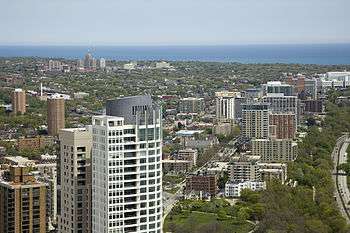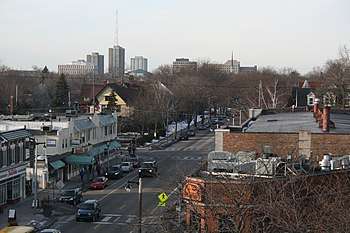East Side, Milwaukee
East Side is a neighborhood of Milwaukee, Wisconsin, considered to be a cultural and trend-setting center of the city since at least the 1960s. Encompassing an area just north of the Historic Third Ward neighborhood to the village of Shorewood, bordered by the Milwaukee River to the west and Lake Michigan to the east, the area encompasses residences, bars, shops, art theaters, live music clubs and the University of Wisconsin–Milwaukee campus.


History
Well-to-do settlers with upper-class roots developed the East Side along the lake. The location has an appeal on the Milwaukee bluffs of Lake Michigan. Many of the extravagant homes are still standing today, particularly around the North Point section. Away from the lake, workers for the nearby tanneries settled in, creating an ethnically diverse area over the decades. By the early 1870s East Brady Street began to emerge as a center of Polish commerce with a concentration of working class Polish immigrants living in the surrounding neighborhood. In the 1920s the ethnic focus of the neighborhood began to shift to Italian, reaching its peak in the 1950s.
Culture
The East Side is considered by some as Milwaukee's melting pot, with a mix of hipsters, hippies, college students and young professionals converging in the area's diverse restaurants, bars and stores. The area is also known for its historic architecture, such as St. Hedwig's, on Humboldt Avenue. With the exception of St. Hedwig's, the buildings of the area reflect the styles popular in Milwaukee, including the Italianate, Queen Anne, Classical Revival, and the German Renaissance Revival.

Oriental Theatre, a movie palace still in operation, was built in 1927. The newer University of Wisconsin–Milwaukee was created in 1956. Brady Street became the focus of Milwaukee's counter-culture in the 1960s, with Brady Street Days, head shops, and Kitchen Sink Press, one of the world's largest underground comics publishers. Recently the area has seen housing assessments double. Commerce continues to grow in the neighborhood as a result of continued private and developer investments.
Parks and recreation
The east side is home to renowned parks. Frederick Law Olmsted—famed designer of New York's Central Park—designed both Lake Park and Riverside Park (originally "River Park"), with Newberry Boulevard being the deliberate connector between the two.[1] Lake Park is part of Milwaukee's "Grand Necklace of Parks" and is known for lawn bowling; a French restaurant, the Lake Park Bistro; and the North Point lighthouse. In addition, a good share of the Oak Leaf Trail is routed through the neighborhood.
See also
- Neighborhoods of Milwaukee
- University of Wisconsin–Milwaukee
References
- Knopfelmacher, Dolores. "History of Lake Park". Lake Park Friends. Retrieved October 10, 2016.
